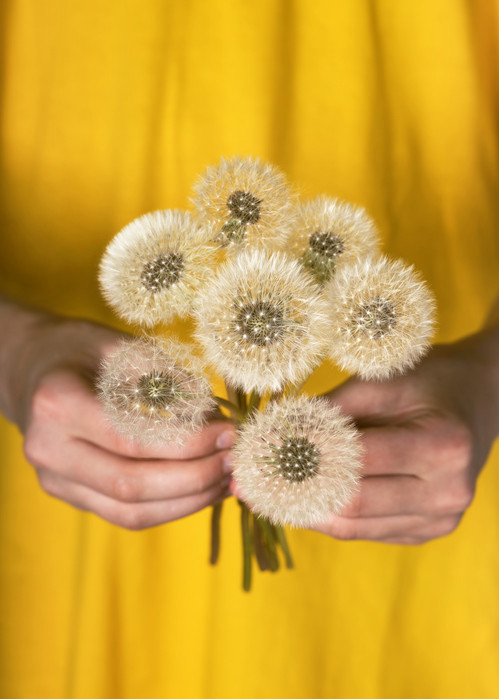May
What’s Dandy About Dandelions?
To weed or not to weed ... that is the question.
A sure sign of spring is dandelions in bloom. This ubiquitous yellow flower seems to spring up overnight to create a cheerful floral display followed by billowy seed heads floating on long stalks above the ground. The word “dandelion” means “lion’s tooth,” probably a reference to its jagged leaves. Whether you love them or hate them, dandelions are among the most familiar plants in the world. They’re one species that just about anyone can identify at a glance. Dandelions are quite possibly the most successful plants that exist, masters of survival worldwide.
Before the invention of lawns, people praised the golden blossoms and lion-toothed leaves as a bounty of food, and medicine. Gardeners often weeded out the grass to make room for the dandelions. But somewhere in the 20th century, wes decided that the dandelion was a weed.
Here are a few things you might not know about dandelions.
- Dandelions have deep roots in history throughout the ages. Dandelions probably arrived in North America on the Mayflower — not as stowaways, but brought on purpose for their medicinal benefits.
- Dandelions are a green and growing first-aid kit. For millennia, people have been using dandelion tonics to help the body’s liver remove toxins from the bloodstream. In the past, dandelions were also prescribed for every ailment, from warts to the plague. To this day, herbalists hail the dandelion as the perfect plant medicine: It is a gentle diuretic that provides nutrients and helps the digestive system function at peak efficiency.
- Dandelions are more nutritious than most of the vegetables in your garden. Data from the U.S. Department of Agriculture reveals how dandelions probably helped alleviate many ailments: They have more vitamin A than spinach and more vitamin C than tomatoes, and they are a powerhouse of iron, calcium, and potassium.
- Dandelions are good for your lawn. Their wide-spreading roots loosen hard-packed soil, aerate the earth, and help reduce erosion. The taproot pulls nutrients such as calcium from deep in the soil and makes them available to other plants. While most think they’re a lawn killer, dandelions actually fertilize the grass.
- Dandelions are masters of survival. But why is this plant so hard to kill? It’s because they are fast growers. The sunny yellow flowers go from bud to seed in days. Their lifespan is long, too — an individual plant can live for years. The roots sink in deeper over the years and can go down 15 feet. The roots clone when divided; a 1-inch bit of dandelion root can grow a whole new dandelion.
- Dandelions are among the most expensive items in the grocery store. Shops sell dried roots as a no-caffeine coffee substitute. They also appear in produce and other sections, and even at the liquor store. You can enjoy a complete meal, from salad greens to dandelion quiche, followed by dandelion ice cream, washed down with dandelion wine. If you overindulge, a cup of dandelion tea is the perfect remedy, since dandelions help the liver flush hangover-inducing toxins from the body.
- Herbicides used on lawns to kill dandelions take a terrible toll on wildlife. Lawns make up 30 million acres of the United States, and Americans use an estimated 80 million pounds of pesticides on them annually. The U.S. Fish and Wildlife Service reports that “homeowners use up to ten times more chemical pesticides per acre on their lawns than farmers use on crops.”
- There’s a safer way to have a dandelion-free lawn! Let the grass grow 3 or 4 inches tall to shade out the sun-loving dandelions, or use specialized tools like The Weed Hound to have a thriving, healthy yard that is safe for kids, pets, and wildlife.


Nearly all parts of this plant can be eaten.
Regardless of which part you intend to eat, make sure the dandelions have not been treated with chemicals and wash them thoroughly to remove all soil and insects from the underside of the leaves or roots. The leaves, which are high in calcium, potassium, and iron, are best when they are young and tender, and they are most flavorful in early spring before the first flower buds appear. The roots can be eaten as a vegetable with a turnip-like flavor if dug in early spring. Be cautious of ingesting too many roots, as they are reported to be both a diuretic and a laxative. Blossoms, too, can be eaten fresh and are sweetest when picked early in the season. They should be used immediately after picking because the flowers will close up quickly. Dandelion sap contains latex, so some people may be allergic to dandelions. Anyone allergic to latex should also avoid handling fresh.
Dandelion recipes:
